Introduction
Managing human factors in project management approach requires leadership skills to ensure success in project implementation. This chapter discusses the plan to grow to the leadership role to help managers enhance effectiveness and productivity at a project.
The four-level growing plan is helpful for managers to manage effectively the implementation of a project.
Objectives
What is the significance of leadership in project management and why growing to a leadership role is important for advancements?
What is an effective model to grow to a leadership role?
What is self-awareness?
What is self-management?
What is self-growth?
What is self-grooming?
The following are discussed:
- Self-Awareness
- Self-Management
- Self-Growth
- Self-Grooming
Exploring what exactly leadership is, what the purpose of leadership is, and what can be accomplished through effective leadership, most will find outrageous answers, but the truth is that true leadership that transforms people begins with self-leadership. When you are able to lead yourself well and have a personal vision of what you would like to accomplish in your own life, then you are in a position to benefit others more.
The leadership skills are learnable, and every professional must learn them to enhance competence for advancement in a career. It starts from self-leadership to create balance in one’s own life and become an effective team member.
The first sign of maturity in a leader is taking responsibility for oneself and one’s decisions. A leader needs to control emotions or the personal environment that resides within. However, when you are struggling to overcome your perceived disadvantages in life, you may still have a long way to go before you will be able to deliver the type of leadership that your team deserves.
Blaming everyone else and pointing fingers is the easiest thing. A quote by the Dalai Lama speaks to this: “When you think everything is someone else’s fault, you will suffer a lot. When you realize that everything only springs from yourself, you will learn both peace and joy.”
Project management systems require a “good fit” of managerial and leadership skills.
Professionals working on a project do not have a choice to acquire only project management skills and leave learning about leadership skills for some later point in time—that only leads to failure. The application of technical tools requires managerial competence, but managing human aspects in the process is possible only with effective leadership skills.
Manage “Good FIT” of Managerial and Leadership Skills
Effectively growing to the leadership role requires four areas of self-development, discussed in the following section.
Self-Development
Your career advancement depends on your leadership capabilities. Leadership starts from self-development and self-leadership. It focuses on building interpersonal relationships with the team and other important contacts in other business units and stakeholders, as well as promoting promising individuals within the team to foster innovation. A leader makes investments for a long-range growth perspective and is considered a “fearless innovator” who challenges the status quo and is always unafraid to take high risks in search of high rewards, for customers, team members, and shareholders alike.
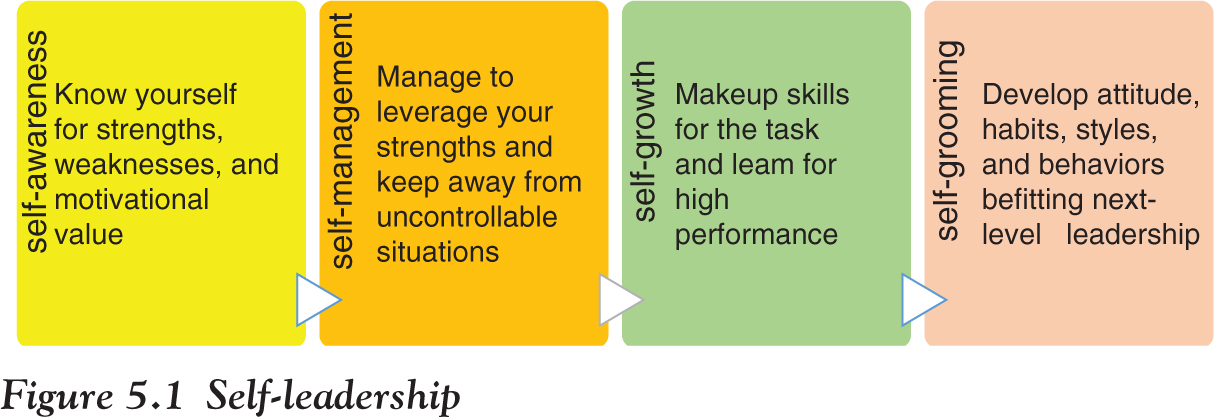
A leader-in-the-making starts from self-leadership practices, shown in Figure 5.1. The dimensions are as follows:
- Self-awareness
- Self-management
- Self-growth
- Self-grooming
5.1 Self-Awareness
To start with, awareness produces realistic self-assessment. When you take awareness seriously, you find yourself asking some fundamental questions: Who am I? What do I want? What does the situation demand?
A leader must ask these questions of himself and inspire the team to ask for themselves. Many would-be leaders shy away from psychology, but that’s not exactly what awareness is.
Henry Ford had almost no inward gaze; his entire life, from childhood onward, was based on a rock-solid self-evaluation.
Consciousness
The crucial secret to success doesn’t lie with anything taught in the conventional wisdom. The secret is to become more aware, to adopt a conscious lifestyle. Only this decision enables you to become dynamic, flexible, and resilient in a crisis. When there is no crisis, awareness leads to better decisions on a day-to-day basis, and a string of right decisions carves out the path to success.
Self-Consciousness
This is the state of mind that occurs when attention is focused on the self. Being self-conscious makes speaking in front of an audience difficult. To talk smoothly on a subject, the focus needs to remain on the subject.
Focusing on the subject makes you more eloquent, and that is simply a matter of self-consciousness.
Conscious Attention
The force of attention on an issue, a matter, a problem, or a challenge makes all the surrounding energy to support you and align with your endeavor.
Conscious Intention
The focus of intention for resolution of an issue, a matter, a problem, or a challenge helps energy transform into a desired solution.
The intensity of intention brings the solution.
Power of Intention
It is the starting point of every need in life. It is the creative power that fulfills all of our desires, whether for money, relationships, spiritual awakening, or love.
Everything that happens in the universe begins with intention. When you decide to choose a profession, buy a birthday present, exercise, or call a friend, it all starts with a conscious intention (see Figure 5.2).
The Steps to Harness Intention
Slip into Gaps
At the conscious level, you are required to place your intentions into gaps. This means you do away with thoughts, memories of bad feelings, fears of all sorts, grudges, and negativity, made possible through concentration and meditation.
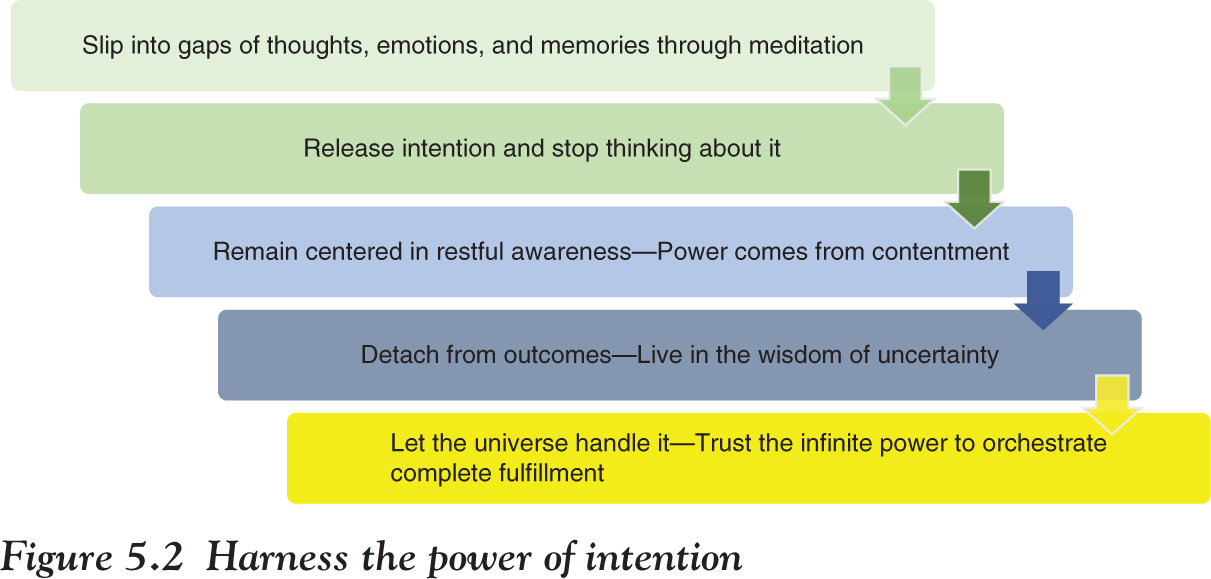
Release Intention
Release your intentions at the conscious level once you are able to reach the highest level of concentration in any sort of meditation. Do not think about the issue anymore.
Power of Contentment
Stay calm and contended after all necessary preparations have been made and actions taken for something better to happen.
Wisdom of Uncertainty
Andy Puddicombe, co-founder of Headspace: A Digital Health and Well-Being Platform, wrote in a blog dated March 9, 2013:
In an uncertain world, it is only natural that we should search for certainty. It provides a feeling of comfort, of safety, perhaps even a sense of purpose or belonging. In a world where everything is constantly changing, where people, places, situations and even our own mind is in a constant state of flux, the illusion of certainty is highly appealing. Furthermore, he says that “there is no shame in not knowing, there is only freedom”. An uncertain mind is an open mind. It is a mind which is curious, interested, reflective and malleable. When we meet life with genuine sense of uncertainty, we cease to project that which we think we know and instead begin to see life for what it really is. The same goes for the people around us. It is only in letting go of our preconceptions and opinions of others that we allow them to be who they truly are, to change and evolve from one moment to the next. The wisdom of uncertainty is not about thinking uncertainty, which is no more than doubt and confusion. On the contrary, this is the direct experience of uncertainty itself, from moment to moment, free from thoughts, judgment, opinion or analysis. It is nothing less than naked awareness, the nature of mind, life itself, unfolding before our eyes.
Self-Discovery for Self-Awareness
The following text has been adapted from Elias H. Porter, psychologist, educator, and author of “The Strength Deployment Inventory (SDI) and Relationship Awareness Theory”:
SDI is the primary inventory of a suite of inventories based on Relationship Awareness Theory—a group of ideas that helps people build productive relationships and manage conflict by providing a window into the motivation that drives behavior.
Relationship Awareness Theory
- Self-awareness through SDI
i. In a normal situation
ii. In a stressful situation
- Motivational value system
- Managing strength
S D I
Strength—helps identify personal strength in relating to others under two conditions:
- When everything is normal and going well
- When faced with conflict or a stressful situation
Deployment—means to move strategically, or to take a position for effective action. The SDI suggests ways that one’s personal strengths may be used to improve relationships with others.
Inventory—SDI is not a test where judgments and “right” or “wrong” answers are graded. It is an inventory for taking stock of motivational values (the basis for how you feel and act in different situations). It is a self-discovery tool.
Self-Assessment
The awareness of self is a tool of leadership, and the strengths and weaknesses help the motivating factor. Self-assessment is learning about what is there and liberating the leader from within. It’s about setting you free and leading to self-development. Through self-development comes the confidence needed to lead. Self-confidence is the awareness of and faith in your own powers. These powers become clear and strong only when you work to identify and develop them.
Learning to lead is about defining what is important with your defined values and what your response would be to questions such as:
- What is my conviction for the vision and value?
- What gives me courage to face uncertainty and adversity?
- What will be my behavior in disappointments, mistakes, and setbacks?
- What is important for improvement of my abilities?
- What is the basis of my relationship with the team?
- What keeps me motivated and encouraged?
- What keeps me going in challenging moments?
5.2 Self-Management
Managerial functions like planning, organizing, coordinating, resource application, and controlling are needed as the base knowledge and added skills for building personal competence, as shown in Figure 5.3.
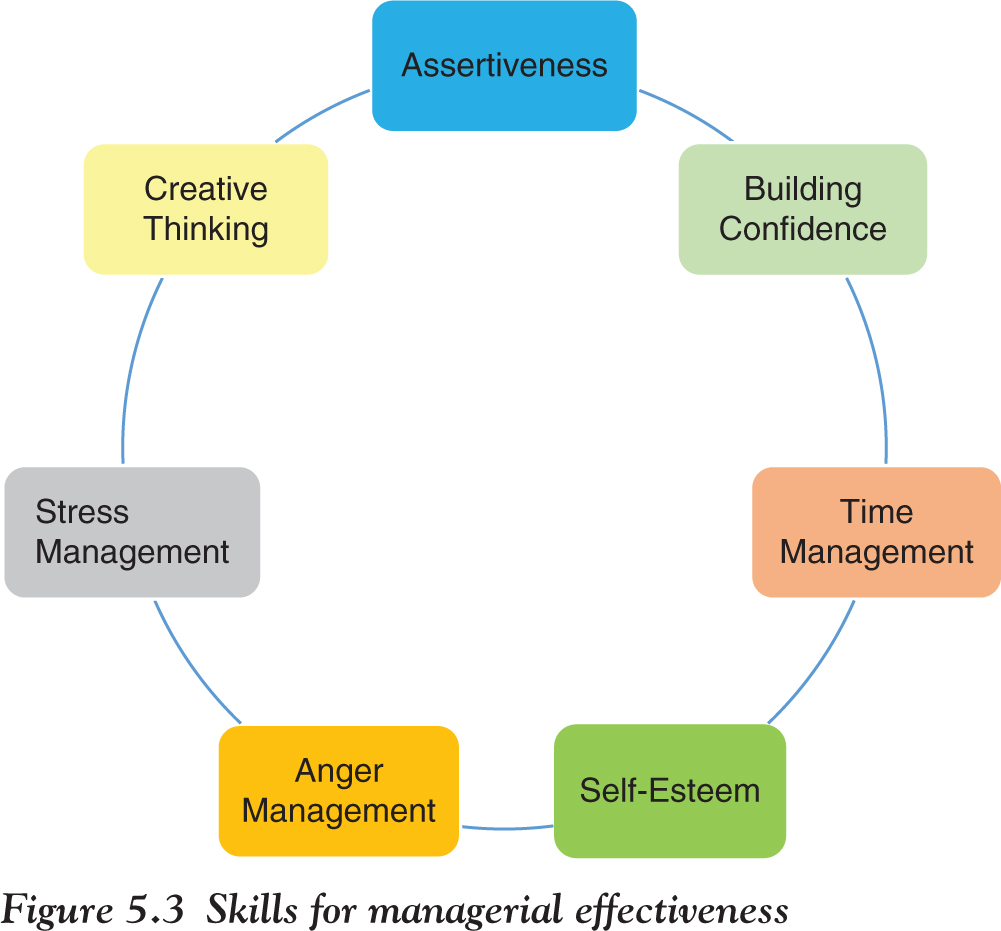
Assertiveness is a skill in social and communication skills training.
Being assertive means being able to stand up for your own or other people’s rights in a calm and positive way, without either being aggressive or passively accepting “wrong.”
Building Confidence
It is known that competence is essential to workplace success, professional achievement, and personal satisfaction. But without confidence, competence will only take you so far. And very often you may experience that too many perfectly capable leaders lack confidence.
Building confidence does not require a complete personality overhaul. Instead, you can take smaller steps to become more self-assured and boost your confidence.
Steps to enhance confidence may be practiced, as shown in Figure 5.4.
- Move out of the comfort zone. Break the tendency of working in your comfort zone and learn to perform in unknown waters.
- Visualize the steps for challenge. This is a strong tool to self-prepare for future challenges. Put yourself in an expected situation and plan how to face it. This way, you are prepared for the unexpected when real challenges arise.
- Assess competence. Evaluate the task and required skills for execution and compare the gaps. The process will enable you to proactively make up for any lapses or add assistance if necessary.
- Create your own environment. When your personality does not match with your work environment, either reshape it with strong competence or move out.
- Support from others. When you have established competence for success and land into a challenging situation, support from others is made available to let you continue.
- Fake it to make it. Visualize to practice and adapt a changed behavior.
- Be the change and make it. Conceptualization and strong planning help build confidence to face challenges.
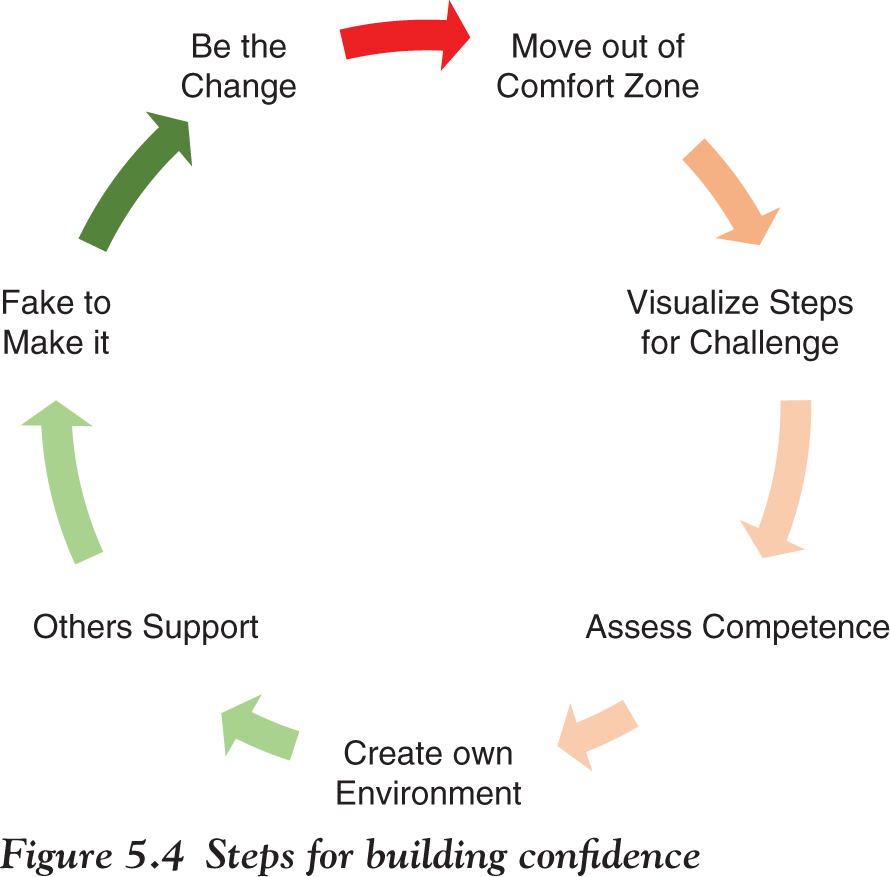
Time Management
Time management is the system to learn and assign priorities to the tasks you wish to accomplish, maximizing discretionary time by minimizing the predictable time and other-imposed time. Plan the use of discretionary time, and learn to be more efficient.
- The key to being an efficient time manager is to learn to maximize discretionary time and use it efficiently.
Time is categorized into three general types:
- Predictable time: Such activities as classes, organization meetings, team practice, eating, and sleeping. If you know the cafeteria is open between 7:00a.m. and 7:30p.m., you should plan to eat sometime between that block of time.
- Discretionary time: This is uncommitted time that should be planned in a manner consistent with your lifestyle and to accomplish the priorities in your life.
- Other-imposed time: This is unpredictable time, comprised of activities including emergencies, work, or other assignments as well as socializing.
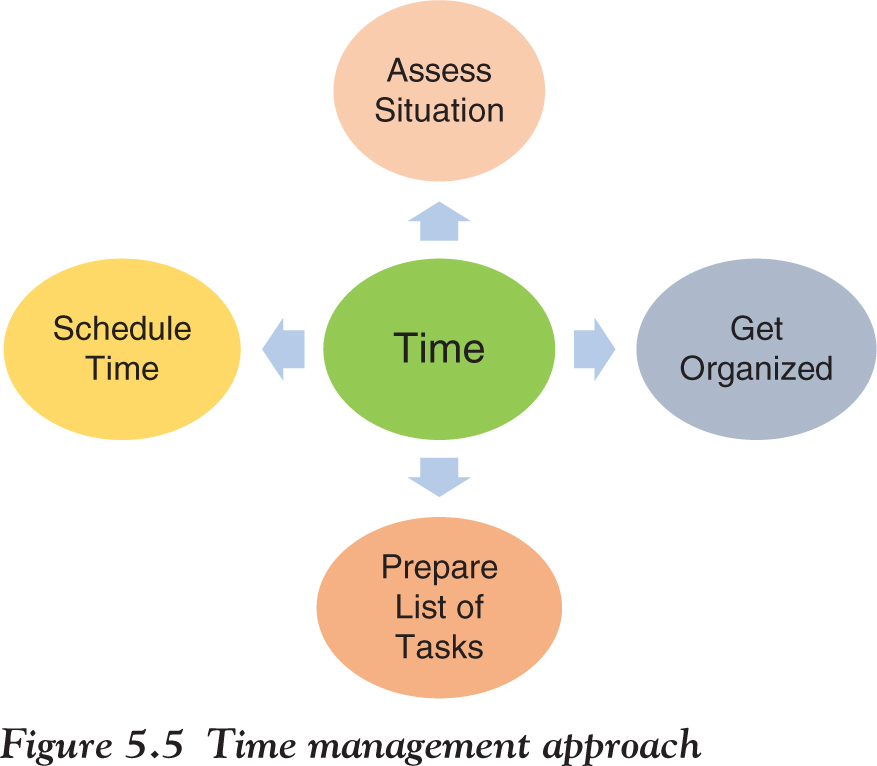
Time management approach is shown in Figure 5.5.
Manage Time
Assess situation—understand what needs to be done.
Get organized—use appropriate tools for scheduling.
Prepare a list—develop a to-do list comprising all tasks in the order of priority.
Schedule time—develop a schedule for all tasks using the available time as a resource.
Self-Esteem
Self-esteem is an outcome of your thoughts, feelings, and opinions about yourself. It is changeable with your thoughts, and therefore, maintaining positive thinking and a positive attitude is important for self-management.
Wikipedia provides the following definitions for self-esteem:
- In sociology and psychology, self-esteem reflects a person’s overall subjective emotional evaluation of his or her own worth. It is a judgment of oneself as well as an attitude toward the self. Self-esteem encompasses beliefs about oneself, (for example, “I am competent,” “I am worthy”), as well as emotional states, such as triumph, despair, pride, and shame.
- Possessing little self-regard can lead people to become depressed, to fall short of their potential, or to tolerate abusive situations and relationships. Too much self-love, on the other hand, results in an off-putting sense of entitlement and an inability to learn from failures.
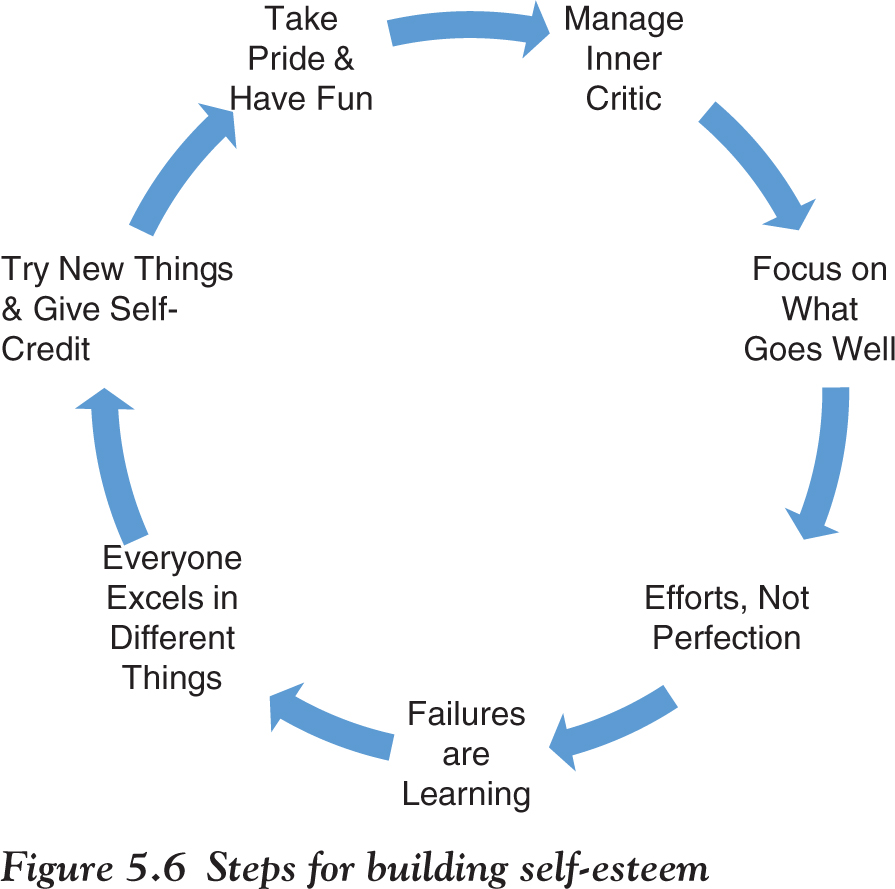
Steps for building self-esteem are shown in Figure 5.6.
- Manage inner critic. When you’re in the habit of thinking self-critically, retrain yourself to change negative or unkind thoughts into more helpful feedback.
- Focus on what is going well. Find something positive each day and write down at least three good things that went well by your action or effort.
- Don’t strive for perfection. Self-pressure to be perfect prevents action and you lose for not trying. When you think you cannot meet requirements, you are guaranteed to fail. Making efforts is the winning factor.
- Learn from failures. Focus on learning from failures; you are the only owner of your actions.
- Don’t compare with others. Focus on what you do well and do away with the inferiority complex. Never compare something specific with others; every one may excel in something.
- Try new things and give self-credit. Test your talent by experimenting with different activities and new things, and take pride in new skills. Think about the good results that add up to self-esteem.
- Take pride and have fun. Achieving goals, accepted opinions and ideas, and recognized contributions are worth taking pride in, so is accepting compliments and celebrating for fun.
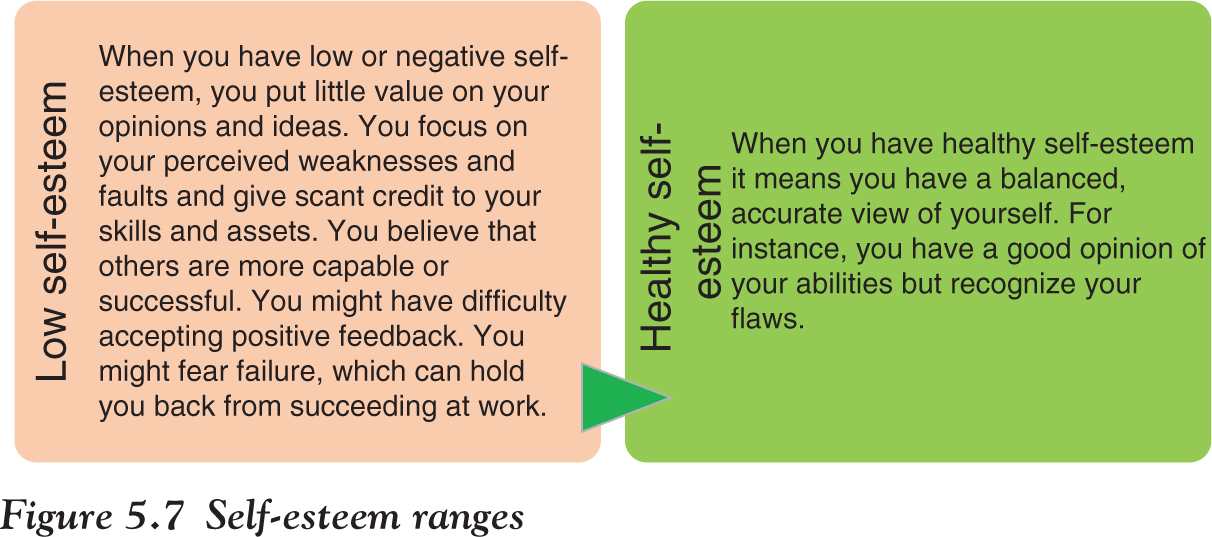
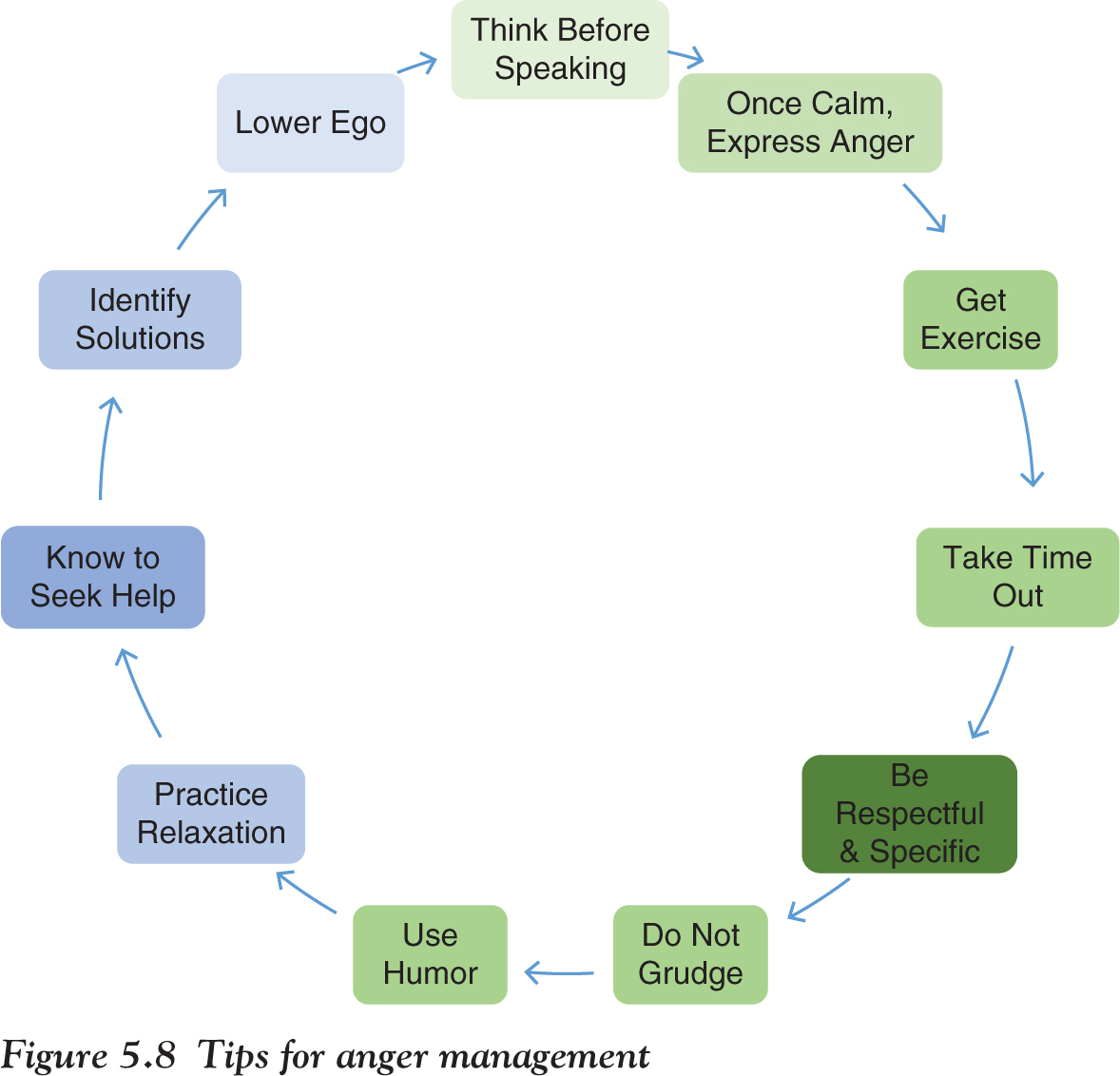
Descriptions for understanding the range of self-esteem are provided in Figure 5.7.
Anger needs to be managed in a positive way, although it is a normal and even healthy emotion. Uncontrolled anger can take a toll on both your health and your relationships.
Tips for anger management are depicted in Figure 5.8.
- Think before speaking. The heat of moment may push you to say something that you regret later or offer clarifications for the rest of the time. The criteria for “THINK” are:
T—true
H—honest
I—inspiring
N—neutral
K—kind
- Once calm, express anger. Express your frustration in an assertive and non-confrontational way. With clarity, say only the concerns without hurting others or trying to control them.
- Get exercise. Regular exercise helps reduce stress that may cause anger. When your anger is escalating, go out for a brisk walk or run, or spend some time doing other enjoyable physical activities.
- Take a time out. When stressed, give yourself short breaks. A few moments of quiet time might help you feel better prepared to handle what’s ahead without getting angry.
- Be respectful and specific. No matter how tense a situation may arise, never ever be disrespectful and remain specific to the issue.
- Do not grudge. Never get personal and do not grudge; just stick to the issue and deal with clarity.
- Use humor. Humor releases the tension in a situation and helps everyone to calm down.
- Practice relaxation. Do not act or discuss an issue reactively; just take time to relax and focus on required improvements rather than punishment. A discussion in a relaxed environment is conducive and yields better results.
- Know to seek help. Know when you may be able to control yourself in a stressful situation, and when you may go out of control, and seek help from peers before hurting yourself or others.
- Identify solutions. Shift your focus on necessary solutions and away from the issues making you angry. In any case, the solution is required, and your show of anger may be coercive for team members.
- Lower ego. Do not let ego play hard in stressful situations that may lead to unending arguments and make things worse.
Stress Management
Although the matter remains in the domain of psychologists, a broader understanding is helpful. Stress management refers to the wide spectrum of techniques and psychotherapies aimed at controlling a person’s levels of stress, especially chronic stress, usually for the purpose of improving everyday functioning.
To identify your true sources of stress, look closely at your habits, attitude, and excuses:
- Do you explain away stress as temporary (“I just have a million things going on right now”), even though you can’t remember the last time you took a breather?
- Do you define stress as an integral part of your work or home life (“Things are always crazy around here”), or as a part of your personality (“I have a lot of nervous energy, that’s all”)?
- Do you blame your stress on other people or outside events, or view it as entirely normal and unexceptional?
Actions to Overcome Stress
The first step is to get yourself up and moving. Here are a few easy ways:
- Put on some music and dance around.
- Take your dog for a walk.
- Walk or cycle to the grocery store.
- Use the stairs rather than an elevator.
- Park your car in the farthest spot in the lot and walk the rest of the way.
- Pair up with an exercise partner and encourage each other as you work out.
- Play ping-pong or an activity-based video game with your kids.
Solutions for reducing stress are presented in Figure 5.9.
Creative Thinking
The following text has been adapted from Porter (2014):
[Porter] suggests that giving yourself five minutes every day to focus on a creative task–writing, doodling, and brainstorming ideas can have a profound impact over time. Cognitive behavioral therapists call it (appropriately enough) the Five-Minute Rule. Commit to doing something for this short interval of time and you’ll overcome the psychological barriers of getting started in the first place.
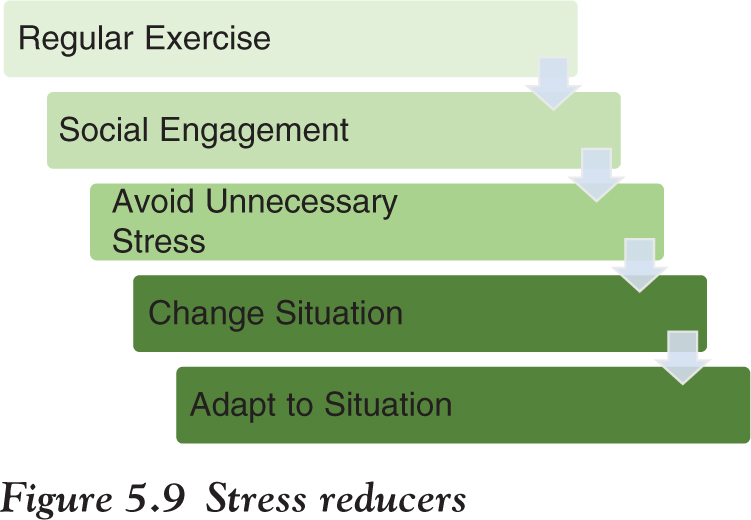
“The biggest magic of the five-minute rule comes from the fact that often, for procrastinators, starting is the hardest part,” writes psychologist Andrea Bonior in Psychology Today.
Tips for developing creativity are depicted in Figure 5.10.
Jane Porter further explained developing creativity as follows:
Creativity
Barrier to start: Usually procrastination is the main reason for not starting something. Practice a strong will to start on important task. There is always the first step to walk a mile.
Mind on creative track: Make a habit of exploring alternative ways of doing a task and note the ideas flashing in mind.
Stop being Precious: Branigan’s Post-it note technique has another benefit: It can help you stop being precious about your work. “Post-its are used and tossed and replaced. It’s never this feeling of trying to do something correctly, which can be overbearing for designers,” he says. “It’s this great feeling of making something and being able to toss it in the end.”
Coming Back: But knowing you’re going to give yourself five minutes for something will make you more likely to return to it. You might even be up for focusing 10 or 20 minutes on it the next time around.
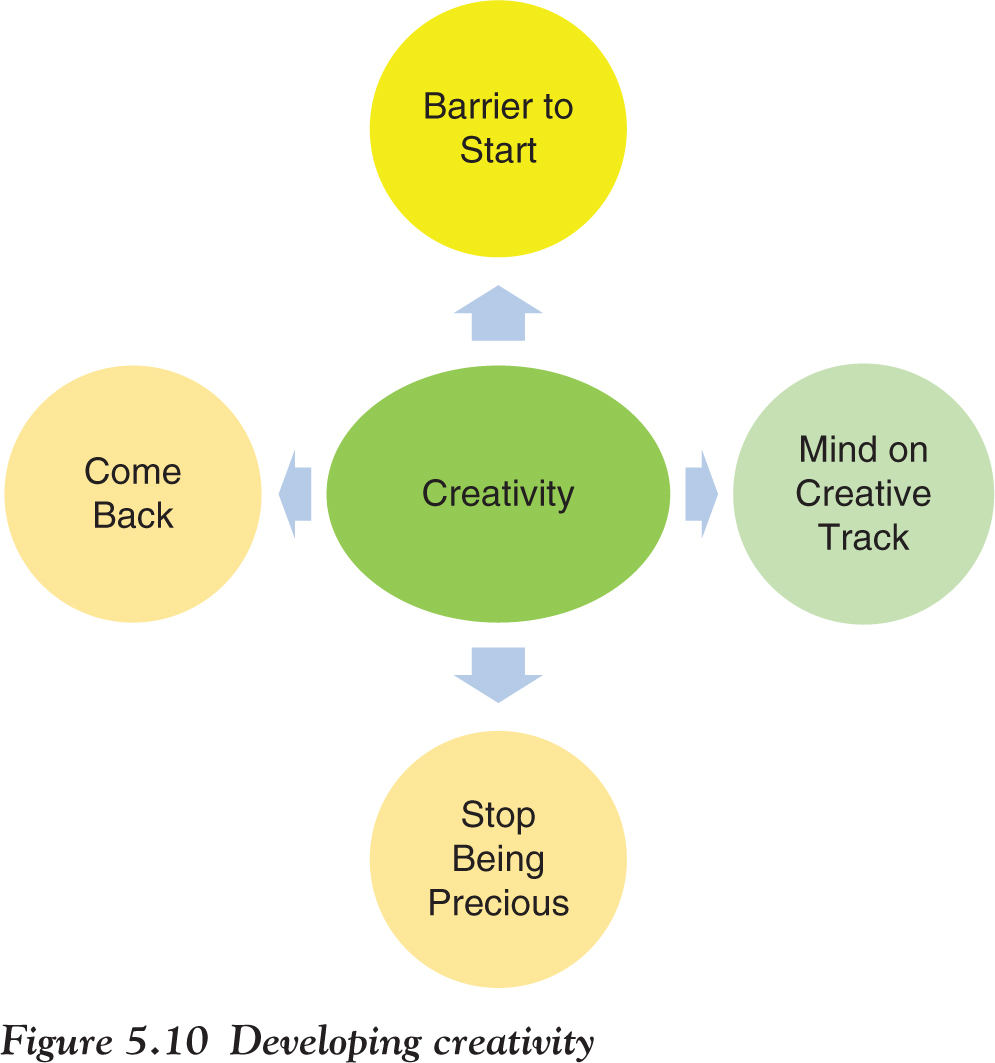
“It’s those small openings and unzippings that in many ways are the biggest psychological barriers of all.”
If you conquer them—doable in just a couple of minutes—and then you force yourself to stop after just that incremental progress, your energy and momentum will have started to flow.
5.3 Self-Growth
Personal growth encompasses the activities that improve self-awareness and self-identity, develop talents and potential, build competence and attract employability of services, enhance quality of life, and effectively contribute to the realization of dreams and aspirations.
- Personal growth means you are in a process of looking at your life, how you are feeling, what is missing, and what can be improved, and you are actively working on improvement through education, new knowledge, increased awareness, and specific changes. You are looking at what your belief system is and making changes to it.
- You are changing your identity to one that more closely aligns with your natural core self, who you really are, what you are really good at and naturally talented in, and what you really want in life.
- One of the major parts of self-growth is learning how to look inside yourself and get clear about certain things.
- Most often, this involves recognizing and dissolving inner blockages. These are usually deep-rooted beliefs that are not going to be touched upon here, because that is for psychologists to deal with.
A recommended process for growth is shown in Figure 5.11.
The Process for Growth

Growth dimensions for the advancement of project management are shown in Figures 5.12. The growth process under each dimension is enumerated further. The dimensions are as follows:
- Professional growth
- Personality growth
- Competence growth
- Emotional growth
- Professional Growth
The stages of professional growth are shown in the Figure 5.13.
The plan for growth is given in Figure 5.14.
- Personality Growth
The following text has been adapted from http://personalitypage.com/html/personal.html:
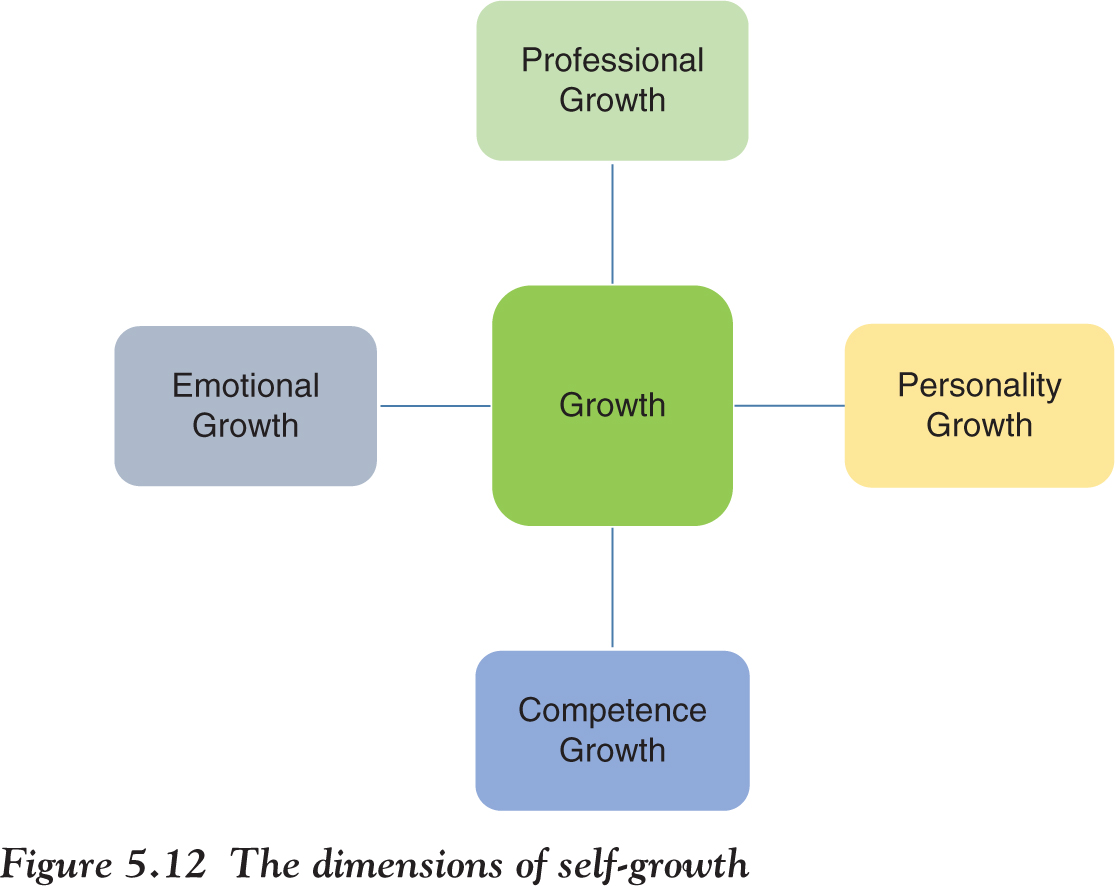
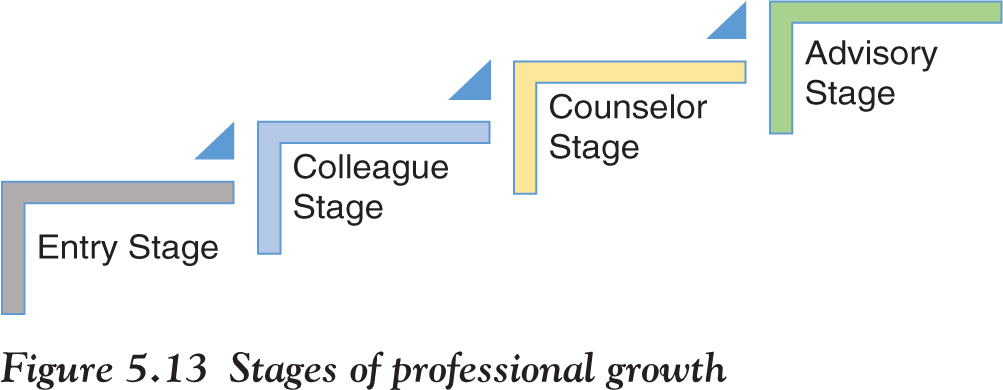
It is essential to have a conscious realization of your true self, beyond the ego that is presented by your conscious self. The personal perspectives and conscious ideas are only a small part of who you are, and the more you try to develop and defend superficial “self,” the further away you get from your true self.
This realization helps an individual in many concrete ways, and is also a positive step toward promoting a “self” that is open to the process of individuation (see Figure 5.15).
- Competence Growth
Competence is the ability of an individual to do a job properly. A competency is a set of defined behaviors that provide a structured guide enabling the identification, evaluation, and development of the behaviors in an individual.
The term “competence” first appeared in an article authored by R.W. White in 1959 as a concept for performance motivation.
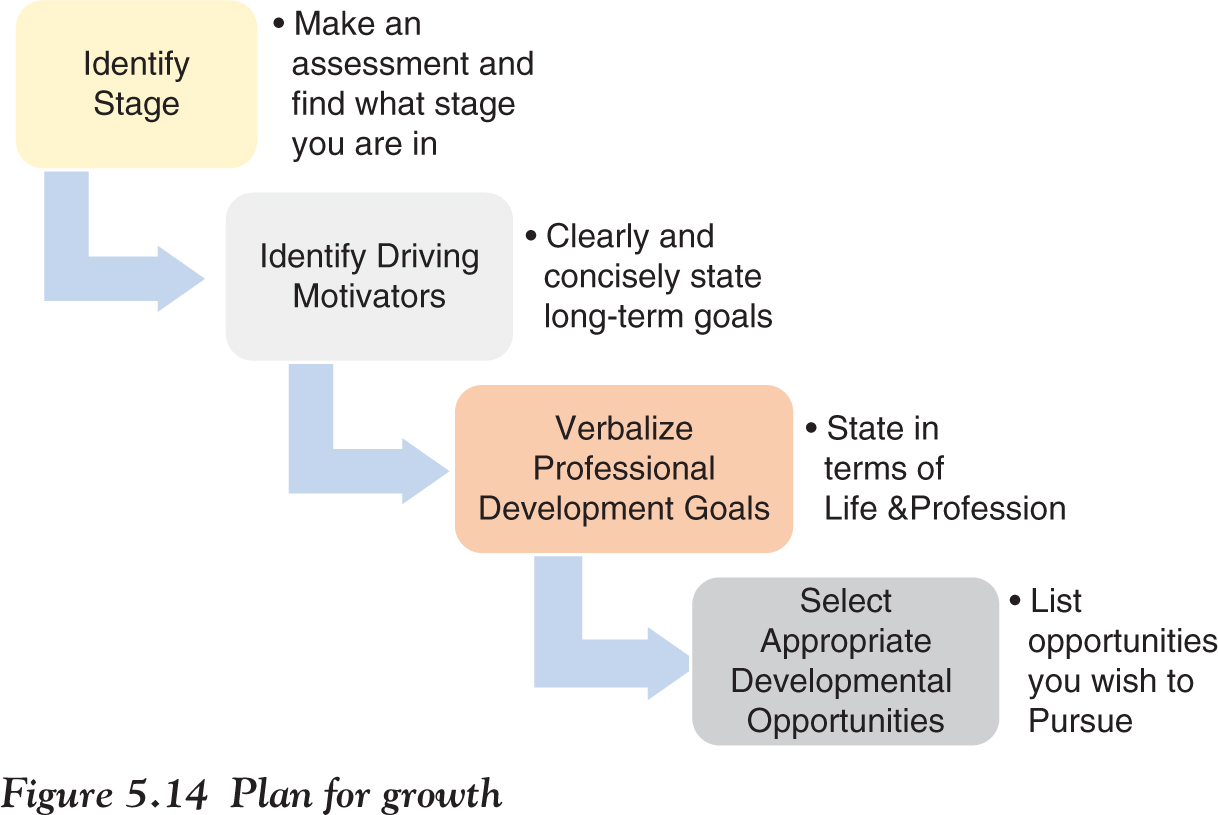
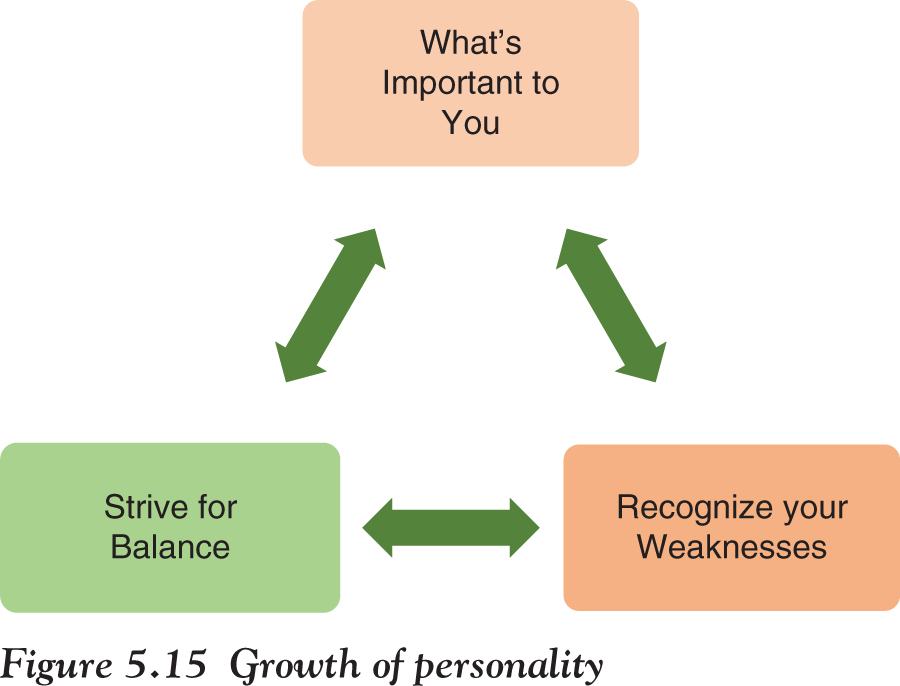
Competencies are what professionals need to be successful in their jobs. Competencies include all the related knowledge, skills, abilities, and attributes that form a task. This set of context-specific qualities is correlated with superior job performance and can be used as a standard against which to measure job performance as well as to develop, recruit, and hire team members.
Performance Management
The critical factors for regular measurement of targeted behaviors and performance outcomes linked to task competency are:
- An understanding of what will be monitored, measured, and rewarded
- A performance appraisal discussion
- A focus for gaining information about a professional’s behavior on the job
- Goal setting around required development efforts and performance outcomes
Stages of competence are highlighted in Figure 5.16.
The following text has been adapted from Wikipedia:
The Four Stages of Competence
- Unconscious incompetence
The individual does not understand or know how to do something and does not necessarily recognize the deficit. They may deny the usefulness of the skill. The individual must recognize their own incompetence, and the value of the new skill, before moving on to the next stage.
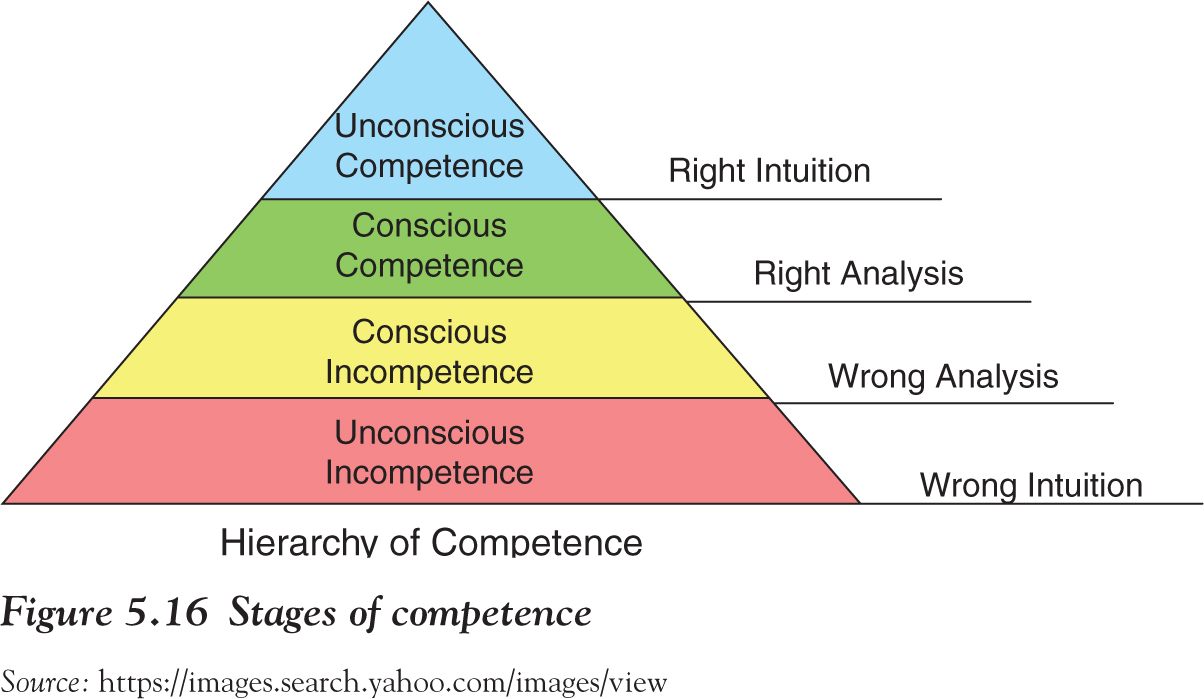
- Conscious incompetence
Though the individual does not understand or know how to do something, he or she does recognize the deficit, as well as the value of a new skill in addressing the deficit. The failure/mistake is integral to the learning process at this stage.
- Conscious competence
The individual understands or knows how to do something. However, demonstrating the skill or knowledge requires concentration. It may be broken down into steps, and there is heavy conscious involvement in executing the new skill.
- Unconscious competence
The individual has had so much practice with a skill that it has become “second nature” and can be performed easily. As a result, the skill can be performed while executing another task. The individual may be able to teach it to others, depending upon how and when it was learned. Solution to issue may even be found through intuition as well.
Understanding of Career Path
An understanding of the stepping stones necessary for advancement and long-term career growth can be accomplished with:
- The skills, knowledge, and characteristics required for the job or role in question and for the follow-on jobs
- Necessary levels of proficiency for follow-on jobs
- Identification of clear, valid, defensible, and achievable benchmarks for team members to ascend the hierarchy
- No guesswork for career progression.
Collectively, all categories of competencies are important to achieve for the advancement of an endeavor and to find excellence in performance. These are shown in Figure 5.17.
- Teamwork: it is the mindset that each team member has learned and understood that the desired end result is not achievable unless a team effort is made.
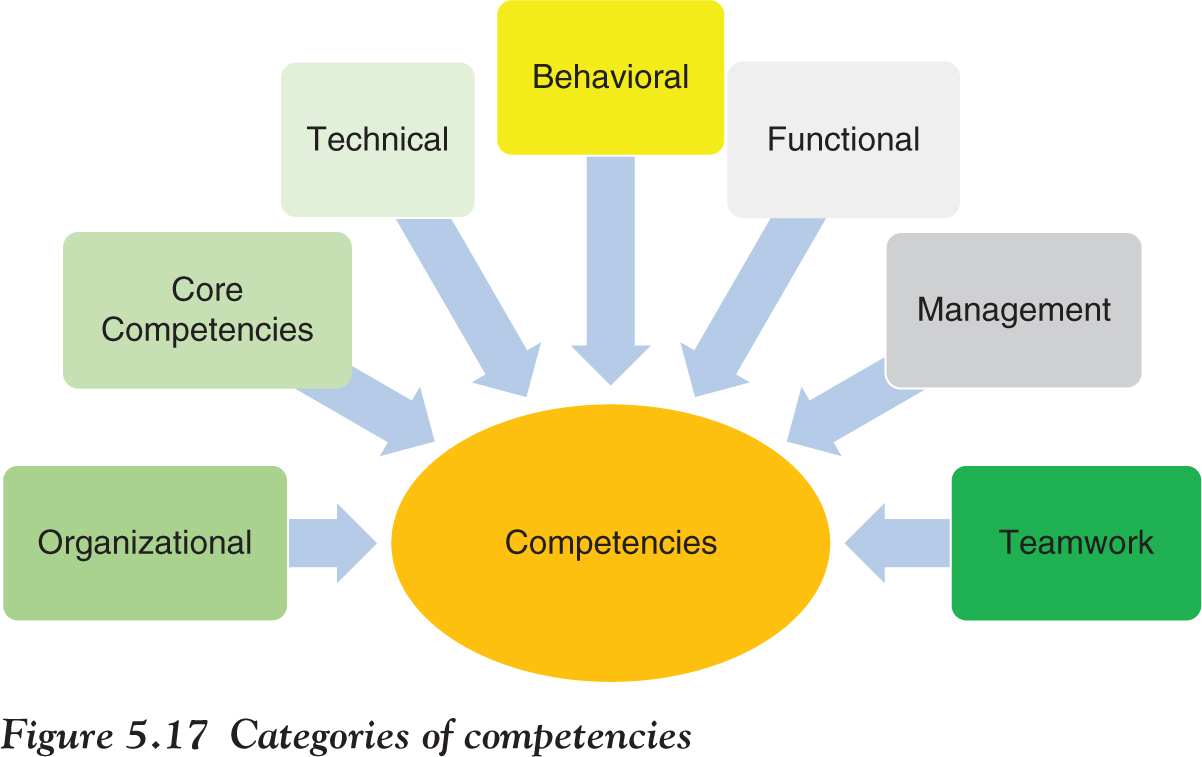
- Management: the basic processes of management are pursued by each team member to make progress.
- Functional: a fair understanding of the functional requirements of a task is learned by each team member.
- Behavioral: an understanding of interrelationship within the team is important and each team member contributes positively at every stage.
- Technical: each member must have a fair understanding of technical aspects of the task that will bring good grasp of work.
- Core competencies: each team member has the core competency for the assigned task to carry it out with excellence.
- Organizational: the structure, the hierarchy, and the behavior of the organization are well known to each team member for efficient progression.
4. Emotional Growth
Daily (within-person) fluctuations in emotional well-being, which is most typically studied in the literature, may be equally important. The three basic needs—autonomy, competence, and relatedness—are satisfied in daily activity.
The following text has been adapted from Boyes (2013):
These ten emotion regulation skills are essential for personal happiness, success, and smooth running relationships.
When you have difficulty in any of these areas, there is a target for you to work on.
- Identifying which specific emotions you’re feeling.
Do you know the difference between feeling jealous and feeling envious? How about the difference between shame and embarrassment? Do you recognize when you’re feeling anxious, angry, or ashamed? Are there some emotions you’re better at identifying in yourself than other emotions? Many have a hard time identifying when they feel ashamed but an easier time recognizing when they feel anxious.
- Identifying which specific emotions someone else is feeling.
Do you notice when your partner is reacting angrily because they are feeling anger + embarrassment, instead of just recognizing the anger element.
Try to label others’ emotions correctly rather than just labeling others as “in a bad mood.”
You’ll be able to provide more effective reactions when you correctly identify which specific emotions other people are having. When realize you’re unsure, you may ask the person to help you understand.
- The ability to start and persist with pursuing goals even when you feel anxious.
When you tolerate feeling anxious you’ll be less likely to avoid trying new things, more likely to try things a second time if it didn’t go well the first time, and less likely to abandon projects before they’ve become successful.
- The ability to tolerate awkwardness.
Do you communicate clearly and directly when it makes sense to do this even when you’re feeling awkward? Do you need to explain to someone, why you’ve decided not to use their service. Or, do you avoid these situations?
- The ability to have intimate conversations rather than stonewall, avoid, or flee.
When your partner wants to talk about having another baby and you’re not on the same page, do you refuse to have the conversation (termed “stonewalling”) try to change the subject whenever it comes up, or disappear from the room when the subject is raised?
- The ability not to crumble when someone is pressuring you.
Do you stand your ground when a salesperson is trying to make a sale by making you feel afraid?
- The ability to soothe your own emotions.
Do you know how to make yourself feel better when something goes wrong or you realize you’ve made a mistake with something?
- The ability to soothe other people’s emotions.
Do you feel confident in your ability to comfort other people when they’re distressed?
- Can you wait?
Are you able to wait till tomorrow to eat the rest of the dessert you made when you’ve already had one portion?
- Do you know how to manage your positive emotions?
Do you regularly schedule activities you know you’ll look forward to?
5.4 Self-Grooming
In order to walk step by step with society, without forgetting your roots, you must start from physical appearance, and then gradually switch to behavioral aspects, which include etiquette, body language, and manners. All of these aspects are summed up in Figure 5.18.
Physical Upkeep
It needs to be developed through health, hygiene, and eating habits, as shown in Figure 5.19.
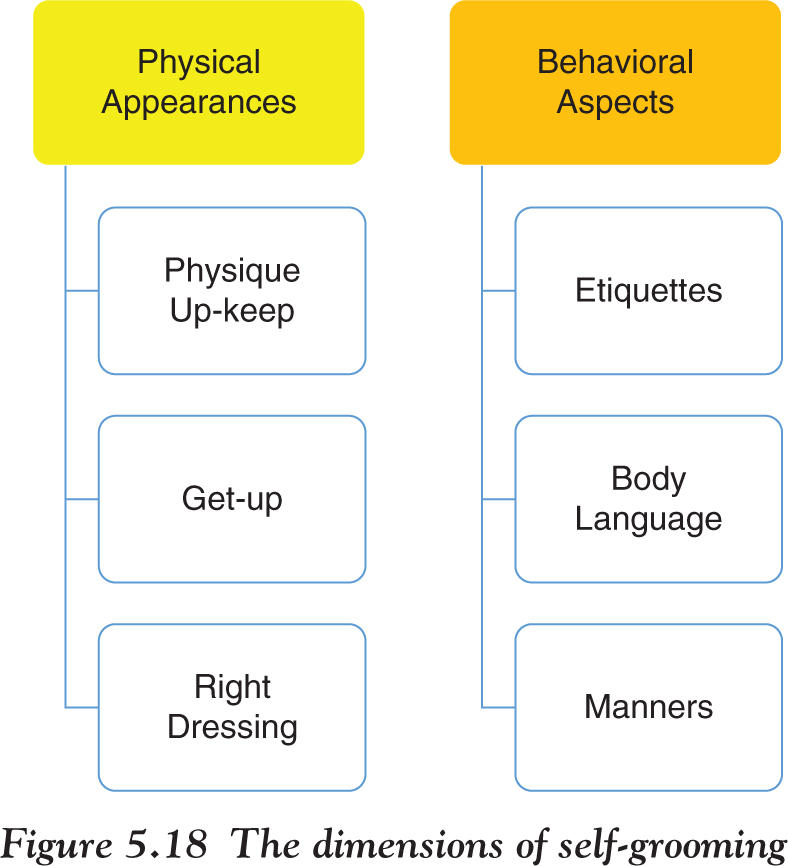
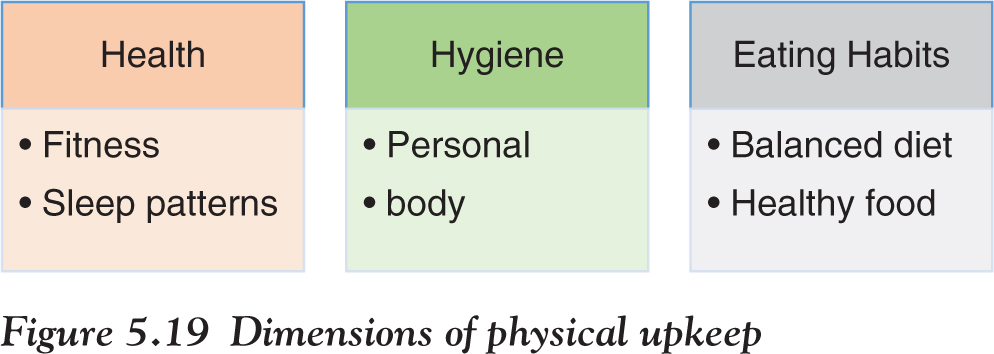
Health and wellness: It starts with figuring out the things you need to live a happy and fulfilling life. The growing number of professionals dealing with debilitating health problems throughout the world makes an emphasis on staying physically and mentally fit more vital. Sleep is important to stay alert, innovative, creative, and focused on job
Hygiene: It is vital for working together where people are conscious of bad odor and keep away from a person if they have had a bad experience once.
Eating habits: Your eating habits influence your behavior and relationship.
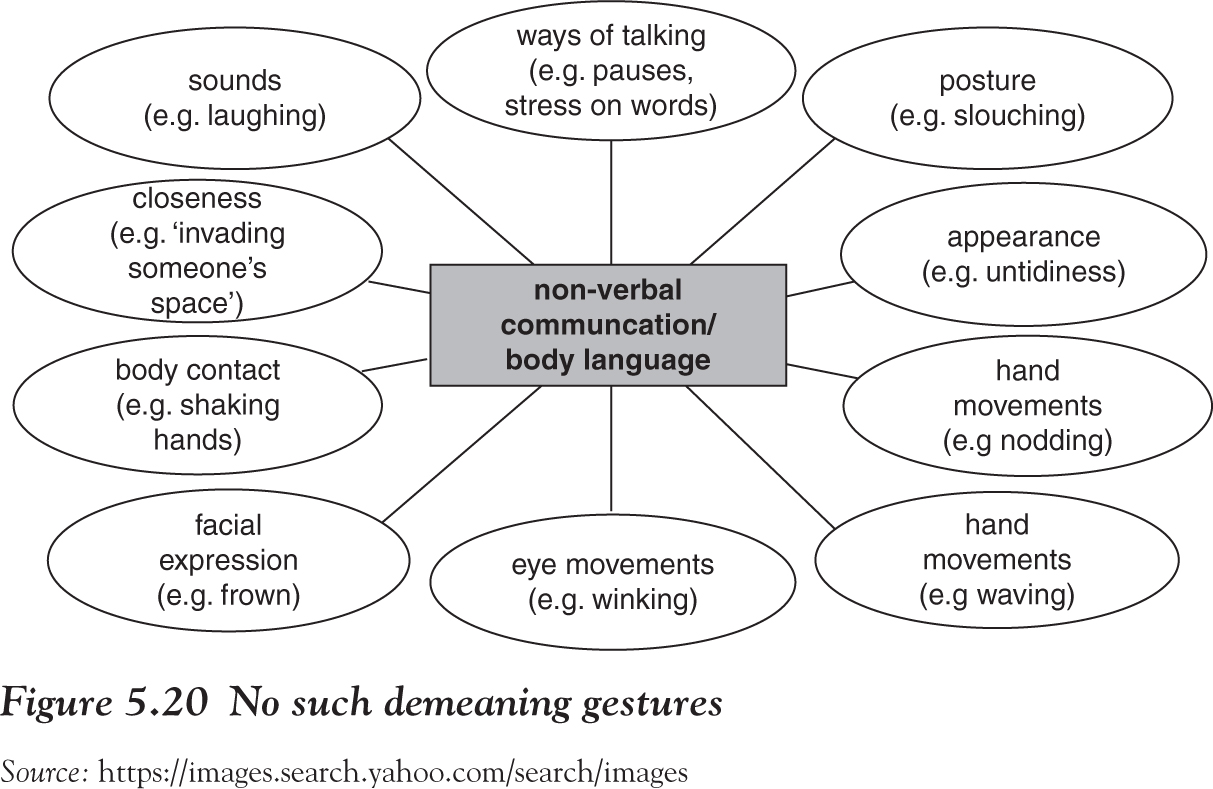
It includes the following:
Etiquettes: It is common courtesy that delineates expectations for social behavior according to contemporary conventional norms within a society, group, or workplace. It includes hygiene, cultural, and courtesy manners. The pillars are courtesy, respectfulness, and politeness.
Body language: Under no circumstances show a negative gesture like the one noted in Figure 5.20.
Manner: Follow the norms and acceptable behavior, such as no staring, respecting elders, and following organizational policy requirements.
Summary
An understanding of the challenges and the significance of leadership in project management has been provided in this chapter. It is essentially an endeavor for the project management approach in order to build leadership skills among team members working on a project.
This chapter also provides the clarity to do away the misconceptions of managers who are skeptical about leadership skills for enhancing performance. Managerial skills considered sufficient for managing success have often proved wrong. A model has been presented in the chapter to help evaluate a gap in the managerial to leadership growth and to develop a plan to build the right skills for a leadership role and for moving to the next level of performance.
References
Body Language. https://images.search.yahoo.com/search/images
Boyes, A. 2013. “10 Essential Emotion Regulation Skills for Adults,” Psychology Today. https://www.psychologytoday.com/blog/in-practice/201304/10-essential-emotion-regulation-skills-adults
Hierarchy of Growth. https://images.search.yahoo.com/images/view
Personality Growth. http://personalitypage.com/html/personal.html
Porter, J. 2014. “How to Transform Your Creative Thinking in Five Minutes.” https://www.fastcompany.com/3031051/work-smart/how-to-transform-your-creative-thinking-in-five-minutes
Puddicombe, A. 2013. “Headspace a Digital Health and Well-Being Platform,” HuffPost. http://www.huffingtonpost.com/author/andy-puddicombe
Wikipedia. “Self-esteem.” https://en.wikipedia.org/wiki/Self-esteem
